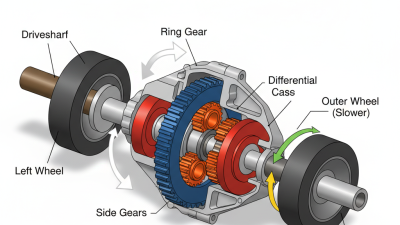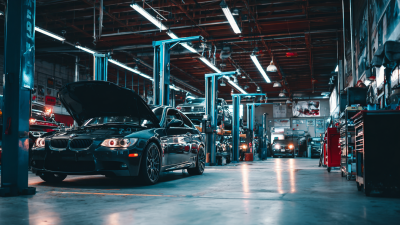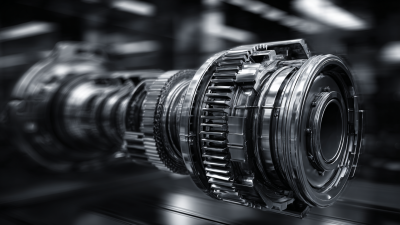Auto Repair Shop In Plainfield, IL
What is a Rear End Differential and How Does It Impact Your Vehicle Performance
 The rear end differential plays a crucial role in the overall performance and handling of a vehicle. This essential component distributes engine torque to the rear wheels, allowing for smoother acceleration and improved traction on various terrains. According to the Society of Automotive Engineers (SAE), the performance of a rear end differential directly influences a vehicle's stability, especially in high-speed cornering scenarios, where proper torque distribution can enhance grip and reduce understeering or oversteering tendencies.
The rear end differential plays a crucial role in the overall performance and handling of a vehicle. This essential component distributes engine torque to the rear wheels, allowing for smoother acceleration and improved traction on various terrains. According to the Society of Automotive Engineers (SAE), the performance of a rear end differential directly influences a vehicle's stability, especially in high-speed cornering scenarios, where proper torque distribution can enhance grip and reduce understeering or oversteering tendencies.
Moreover, advancements in differential technology have led to the development of limited-slip and electronic differentials, which offer significant performance enhancements. Research from the Automotive Research Association indicates that vehicles equipped with more sophisticated rear end differentials can experience up to a 15% increase in acceleration efficiency. This illustrates not only the importance of the rear end differential in modern vehicle design but also its significant impact on driving dynamics and vehicle longevity. Understanding its function and benefits is essential for vehicle enthusiasts and everyday drivers alike, as it can influence their driving experience and maintenance decisions.
Understanding the Basics of Rear End Differentials and Their Functionality
A rear end differential is a critical component of a vehicle’s drivetrain, enabling the wheels to turn at different speeds, especially during cornering. This functionality is paramount for improving handling and stability. According to the Society of Automotive Engineers, properly functioning differentials enhance traction and reduce tire wear, which can lead to a notable increase in overall vehicle performance. In vehicles with rear-wheel drive, the differential facilitates the distribution of engine torque to the rear wheels, thus optimizing acceleration and cornering efficiency.
The design and type of rear end differential can profoundly impact driving dynamics. For instance, limited-slip differentials are engineered to improve grip during acceleration by transferring power to the wheel with the most traction, which is crucial on slippery surfaces. A study published in the Journal of Automotive Engineering highlights that vehicles equipped with advanced differential technology, such as electronically controlled systems, can achieve up to a 20% improvement in handling and stability under dynamic conditions. Understanding the basics of rear end differentials not only aids in vehicle performance assessment but also informs drivers about maintenance needs, ensuring optimal operational longevity.
The Role of Gear Ratios in Performance and Fuel Efficiency
The rear end differential is a crucial component in a vehicle’s drivetrain, affecting both its performance and fuel efficiency. One of the key aspects of this system is the gear ratio, which is determined by the number of teeth on the gears involved. A lower gear ratio typically provides better acceleration and torque, making it ideal for performance-oriented driving. Conversely, a higher gear ratio can enhance fuel efficiency during steady-state cruising, as it allows the engine to operate at lower RPMs.
The impact of gear ratios becomes particularly significant in different driving scenarios. For instance, a vehicle designed for off-road capability may benefit from a lower gear ratio to maximize torque and traction on challenging terrains. In contrast, a sports car focused on speed and agility will often utilize a higher gear ratio for faster highway speeds without straining the engine. Understanding how gear ratios function within the rear end differential can thus enable drivers to optimize their vehicles for both performance and fuel efficiency, ensuring a more tailored driving experience.
Types of Rear End Differentials: Which One Is Right for Your Vehicle?
When considering the right rear end differential for your vehicle, it’s essential to understand the main types available: open, limited-slip, and locking differentials. Each type has its unique benefits and drawbacks, impacting your vehicle’s performance based on driving conditions and style. According to the Automotive Journals of 2022, open differentials are the most common, allowing for independent wheel rotation and providing a smoother ride. However, they can struggle in low-traction situations, which is where limited-slip differentials shine by automatically distributing power to the wheel with better grip. This type can lead to a 30% improvement in traction as reported in the SAE International studies.
For off-road enthusiasts or those who navigate challenging terrains, locking differentials are often the preferred choice. They engage both wheels equally, providing maximum traction in severe conditions. Research from the Off-Road Vehicle Institute indicates that locking differentials can enhance off-road performance by over 50%, making them ideal for rugged adventures. Ultimately, selecting the right type of rear end differential depends on understanding your driving habits and the environments you frequent, ensuring you optimize both performance and safety.
How Differential Locking Mechanisms Enhance Traction and Control
A rear end differential is a critical component of a vehicle’s drivetrain that allows the wheels to rotate at different speeds while still providing power. This is especially important during turns, as the outer wheels need to cover a greater distance than the inner ones. However, in challenging driving conditions such as off-road terrains or slippery surfaces, standard differentials can struggle to maintain traction, which is where differential locking mechanisms come into play.
Differential locking mechanisms enhance traction and control by ensuring that both wheels on an axle turn at the same speed, regardless of the road conditions. When one wheel encounters a slippery surface, it may spin freely, causing a loss of traction. By engaging the locking mechanism, power is distributed equally to both wheels, significantly improving grip. This is especially beneficial in off-road situations or when navigating steep inclines, allowing vehicle operators to conquer obstacles that would otherwise be insurmountable. Ultimately, these mechanisms provide drivers with greater stability and confidence, ensuring optimal performance across various terrains.
Impact of Differential Type on Vehicle Traction
The Impact of Differential Maintenance on Longevity and Performance
The differential is a crucial component of a vehicle's rear end, playing a vital role in the distribution of power to the wheels. Proper maintenance of the differential is essential for ensuring both longevity and optimal performance. Neglecting this aspect can lead to a host of issues, such as uneven tire wear, reduced fuel efficiency, and even complete differential failure. Regular checks and fluid changes are necessary to keep the gears lubricated and functioning smoothly, as this reduces friction and wear over time.
Moreover, the impact of differential maintenance extends beyond just the immediate functionality of the vehicle. A well-maintained differential enhances driving stability and ensures smooth power delivery, especially during turns. Drivers may notice enhanced handling and improved traction, particularly in adverse weather conditions. Therefore, investing time in routine differential maintenance not only prolongs the lifespan of the component but also significantly boosts overall vehicle performance, ensuring a safer and more enjoyable driving experience.
What is a Rear End Differential and How Does It Impact Your Vehicle Performance - The Impact of Differential Maintenance on Longevity and Performance
| Dimension | Description | Impact on Performance | Recommended Maintenance Interval |
|---|---|---|---|
| Differential Type | Open, Limited-Slip, or Locking Differential | Affects traction and handling characteristics | Every 30,000 to 50,000 miles |
| Fluid Type | Synthetic or Conventional Gear Oil | Influences lubrication and heat dissipation | Check every 15,000 miles |
| Seal Condition | Integrity of seals to prevent leaks | Prevents fluid loss, essential for proper lubrication | Inspect during every oil change |
| Bearings | Components that support the gearset | Wear can cause noise and reduced performance | Inspect at 50,000 miles |
| Gear Ratio | Ratio of input to output driveshaft rotations | Affects acceleration and fuel efficiency | Evaluate based on driving needs |
Related Posts
-

Revolutionizing Your Skills: The Ultimate Guide to Auto Repair Programs for Beginners
-

Expert Tips for DIY Honda Transmission Repair: Save Money and Enhance Performance
-

Essential Tips to Choose the Right Car Garage Repair Service for Your Vehicle Maintenance Needs
-

Essential Guide to Mobile Transmission Repair Services and Tips for Vehicle Longevity
-

Why Automotive Repair Programs Are Essential for Cutting Repair Costs and Enhancing Service Efficiency
-

Understanding the Essentials of Transmission Rebuilders: Key Insights from Industry Statistics
Contact Us
Service Area
Plainfield, 60585, 60544, 60586, Naperville, 60564, Bolingbrook, 60490, 60440, Romeoville, 60446, Will, Kendall, DuPage, Counties. Our auto repair shop in Plainfield, IL, has been serving the local area plus all surrounding Chicagoland since 1978.
Specialties
• Computer Diagnostic • Brake Shop • Engine Replacement • Transmission Rebuild • Clutch Replacement • Differential Rebuild • Suspension Shop • Steering • Shocks & Struts • Heating & Cooling • Electrical • Exhaust Shop • Catalytic Converter Replacement • Alignment • Domestic & Foreign Vehicle Service • Auto Repair In Plainfield, IL • Auto Repair Shops Near Me • Towing Service Near Me

